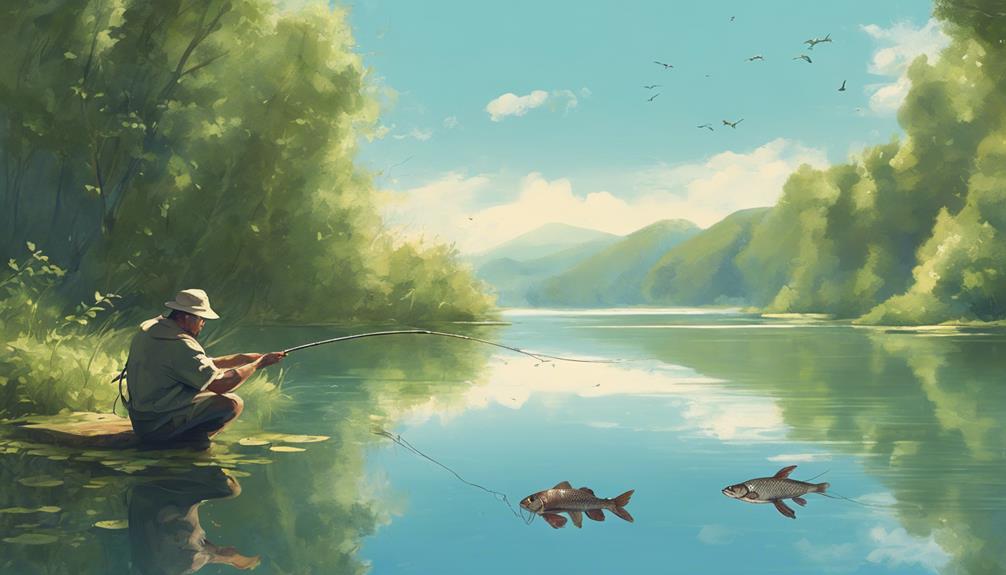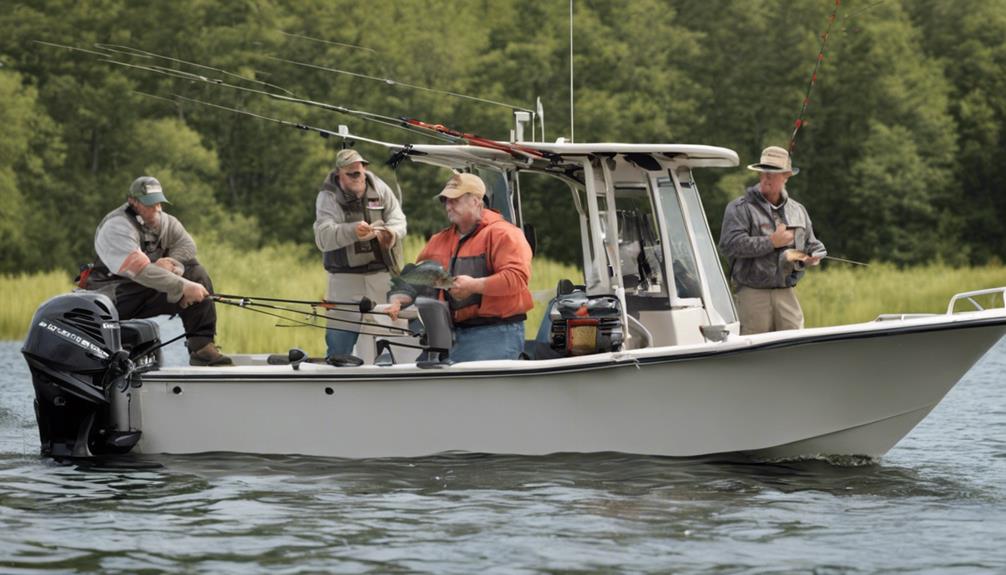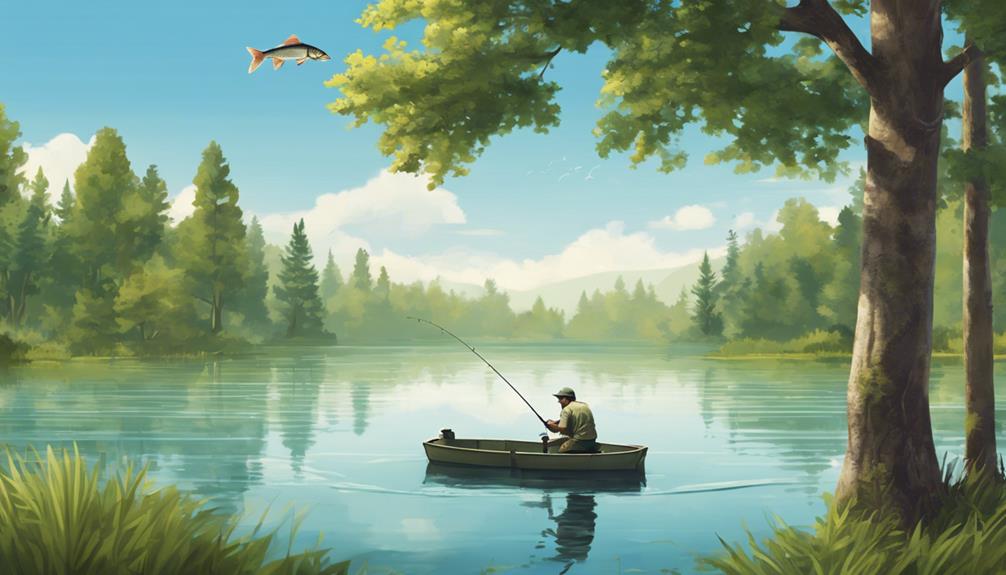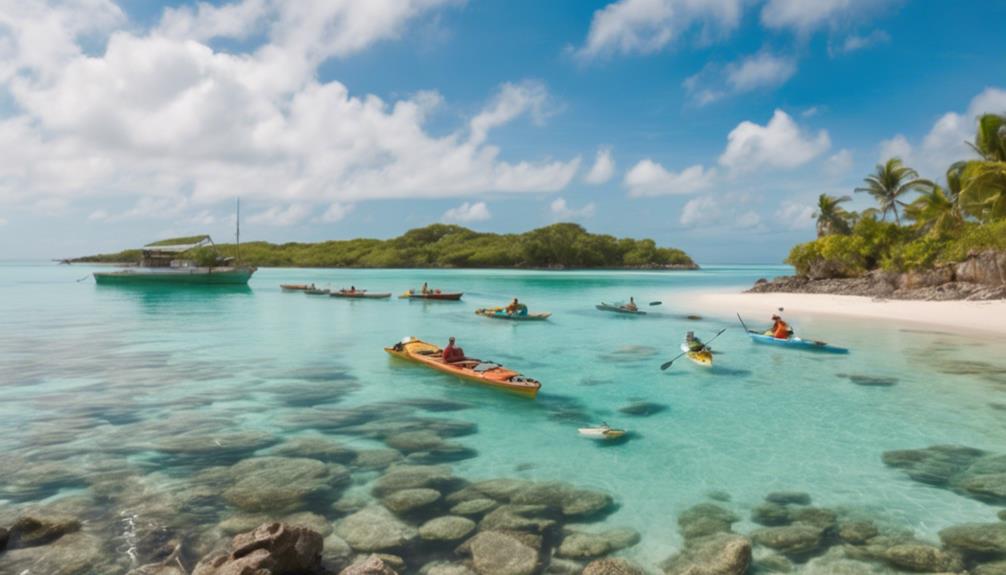Imagine a vast ocean, teeming with life and possibilities, where the rhythm of the waves mirrors the delicate balance of its inhabitants.
Understanding fishing conservation is like peering beneath the surface to uncover a world intricately connected yet at risk of disruption. By grasping the significance of sustainable practices, you not only safeguard the future of marine ecosystems but also ensure abundant fish stocks for generations to come.
The intricate web of fishing conservation holds secrets that can shape the fate of our oceans and the well-being of all who depend on them.
The Basics of Fishing Conservation
To effectively practice fishing conservation, it's crucial to understand the fundamental principles that govern sustainable fishing practices. Habitat preservation plays a vital role in maintaining healthy fish populations. By protecting and restoring habitats such as coral reefs, mangroves, and wetlands, you can ensure that fish have safe spaces to reproduce and thrive. Additionally, implementing catch limits is essential to prevent overfishing and preserve fish stocks for future generations. It's important to adhere to these limits to maintain a balanced ecosystem and prevent the depletion of fish populations.
Environmental stewardship is another key aspect of fishing conservation. As a responsible angler, you should strive to minimize your impact on the environment. This can be achieved by properly disposing of trash, using environmentally friendly fishing gear, and avoiding harmful practices that can damage marine ecosystems. By practicing environmental stewardship, you contribute to the overall health of aquatic habitats and help protect vulnerable species.
Fish stock assessment is a critical tool in monitoring the health of fish populations. By collecting data on population sizes, growth rates, and reproduction, scientists can determine the status of various fish species. This information is crucial for establishing sustainable fishing practices and making informed decisions regarding catch limits and conservation measures. By supporting fish stock assessment efforts, you contribute to the long-term sustainability of fisheries and ensure that fish populations remain healthy and abundant.
Importance of Sustainable Fishing Practices
Implementing sustainable fishing practices is crucial for preserving marine ecosystems and ensuring the long-term viability of fish populations. By following ethical angling practices and promoting environmental stewardship, we can contribute to marine conservation and the establishment of sustainable fisheries. Ethical angling practices involve respecting catch limits, releasing undersized fish, and using gear that minimizes harm to non-target species. This approach helps maintain balanced ecosystems and allows fish populations to thrive.
Environmental stewardship plays a vital role in sustainable fishing practices. It involves reducing pollution, protecting habitats, and minimizing bycatch to safeguard the delicate balance of marine ecosystems. Sustainable fisheries aim to harvest fish in a way that doesn't deplete populations, ensuring that future generations can continue to enjoy seafood and marine biodiversity. By supporting sustainable fisheries, you actively participate in the conservation of our oceans.
Engaging in sustainable fishing practices not only benefits the environment but also contributes to the economic and social well-being of communities that rely on fishing. By choosing sustainably sourced seafood, you promote responsible fishing methods and support the livelihoods of fishermen who depend on healthy fish stocks. Your actions today can have a positive impact on the future of our oceans and the creatures that call them home.
Impact of Overfishing on Ecosystems
Following sustainable fishing practices is essential for preserving marine ecosystems and ensuring the long-term viability of fish populations; however, the impact of overfishing on ecosystems can't be overlooked. Overfishing disrupts the delicate balance within ecosystems, leading to species depletion and biodiversity loss.
When certain fish species are overexploited, their populations decrease significantly, causing ripple effects throughout the entire ecosystem. For example, the depletion of large predatory fish can result in an explosion of smaller fish populations, disrupting the natural food chain and ecosystem dynamics. This imbalance can lead to the decline of certain species that depend on those smaller fish for food, ultimately affecting biodiversity.
The environmental consequences of overfishing are far-reaching. As fish populations dwindle, it can disrupt the oceanic food web, impacting not only marine life but also seabirds and other animals dependent on fish for sustenance. Moreover, the depletion of certain fish species can lead to the loss of key ecosystem functions, such as nutrient cycling and habitat maintenance.
To mitigate the negative effects of overfishing on ecosystems, it's crucial to implement sustainable fishing practices, such as setting catch limits, protecting marine habitats, and enforcing regulations to prevent overexploitation. By prioritizing ecosystem health and species conservation, we can work towards restoring balance and preserving the biodiversity of our oceans.
Benefits of Marine Protected Areas
Within marine protected areas, diverse ecosystems thrive under the safeguard of conservation measures. These areas offer a multitude of ecological benefits by preserving fragile habitats and protecting a wide array of marine species. Marine protected areas play a crucial role in biodiversity protection by providing safe havens for various plants and animals to flourish without the threat of overexploitation.
One of the key advantages of marine protected areas is habitat restoration. By limiting human activities such as fishing and pollution within these designated zones, damaged habitats have the opportunity to recover and regenerate. This restoration process is essential for maintaining the balance of marine ecosystems and ensuring the long-term sustainability of marine life.
Moreover, marine protected areas contribute significantly to tourism revenue. These areas attract visitors who are interested in experiencing the beauty of untouched marine environments and observing diverse marine species in their natural habitats. The tourism industry benefits from the presence of marine protected areas through activities like snorkeling, diving, and eco-tours, which generate income for local communities and economies.
In essence, marine protected areas serve as invaluable tools for conservation efforts, offering a sanctuary for marine life to thrive, promoting habitat restoration, and contributing to economic growth through sustainable tourism practices. By recognizing the importance of these areas, we can work towards preserving our oceans for future generations to enjoy.
Role of Anglers in Conservation Efforts
Anglers play a crucial role in conservation efforts by actively engaging in sustainable fishing practices to protect marine ecosystems and species. As an angler, you hold a significant responsibility to ensure the health and sustainability of marine environments. By practicing catch and release techniques, respecting catch limits, and avoiding sensitive areas like coral reefs, you contribute directly to conservation efforts. Your actions can help preserve fish populations and maintain the delicate balance of marine ecosystems.
Community engagement is another vital aspect of anglers' role in conservation. By participating in local clean-up events, joining conservation organizations, and educating fellow anglers about sustainable practices, you can have a broader impact on marine conservation. Your advocacy for responsible fishing practices can inspire others to follow suit, creating a ripple effect within the angling community.
Taking on the responsibility of conservation as an angler isn't just about catching fish; it's about being a steward of the marine environment. Your actions, no matter how small they may seem, can make a significant difference in preserving the biodiversity of our oceans. By actively engaging in conservation efforts and advocating for sustainable practices, you contribute to the long-term health and vitality of marine ecosystems for future generations to enjoy.
Regulations for Responsible Fishing
To ensure sustainable fishing practices and protect marine ecosystems, it's essential to adhere to regulations for responsible fishing. Catch limits play a crucial role in maintaining fish populations at healthy levels. By setting specific catch limits for different species, authorities can prevent overfishing and ensure that fish stocks aren't depleted beyond recovery. These limits are based on scientific research that takes into account the reproductive rates of fish species and their overall population health.
Monitoring systems are another key aspect of responsible fishing regulations. These systems help track fishing activities, enforce catch limits, and detect any illegal or unsustainable practices. By using technologies like satellite tracking, onboard observers, and electronic reporting, authorities can better regulate fishing activities and ensure compliance with established rules. Monitoring systems also enable data collection on fishing trends, which can inform future conservation efforts and policy decisions.
Understanding Fish Population Dynamics
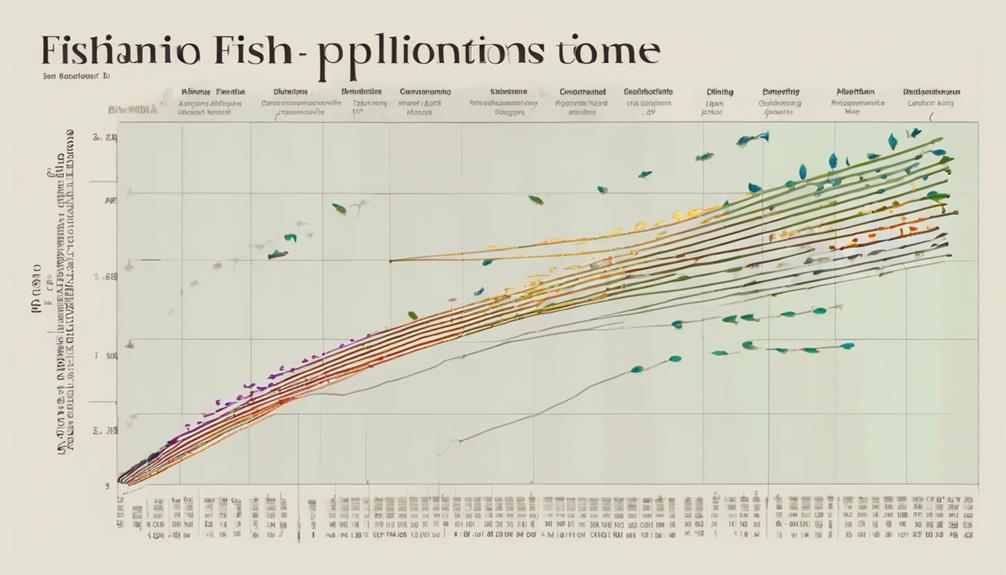
Exploring the intricate balance of fish population dynamics reveals the complex interplay of various factors influencing the health and sustainability of marine ecosystems. Understanding population trends is crucial in determining the overall well-being of fish species. Stock assessment, a key aspect of this understanding, involves evaluating fish populations through data collection and analysis. By examining factors such as growth rates, mortality, and recruitment, scientists can gauge the status of a fish stock and make informed decisions regarding management strategies.
Ecological factors play a significant role in fish population dynamics. Elements like habitat quality, food availability, predation, and environmental conditions all contribute to the fluctuations in fish populations. For instance, changes in ocean temperature can impact the distribution and behavior of fish species, ultimately affecting their abundance.
To ensure the long-term sustainability of fish populations, effective management strategies are essential. Fisheries management employs techniques such as setting catch limits, implementing size regulations, and creating marine protected areas to conserve fish stocks. These strategies aim to prevent overfishing, promote population growth, and maintain ecological balance within marine ecosystems.
Conservation Success Stories in Fishing
In the realm of fishing conservation, remarkable success stories showcase the positive impact of dedicated conservation efforts on marine ecosystems and fish populations. Conservation partnerships and community involvement have played a crucial role in the restoration of once-depleted fish stocks. By working together with local communities, governments, and non-profit organizations, sustainable fishing practices have been implemented, leading to significant recoveries in fish populations.
Innovative technology has also been instrumental in these conservation success stories. Through the use of advanced tracking devices and data analytics, researchers have been able to monitor fish populations more accurately. This technology has enabled conservationists to assess the effectiveness of their strategies in real-time, making adjustments as needed to ensure the long-term health of marine ecosystems.
One inspiring example of conservation success is the recovery of the North Atlantic bluefin tuna population. Through conservation partnerships between fishing industries, environmental groups, and government agencies, strict catch limits and enforcement measures were put in place. Community involvement was also key, with fishermen actively participating in data collection and supporting conservation efforts. As a result, the once-declining bluefin tuna population has shown signs of recovery, demonstrating the power of collaborative conservation efforts in protecting our oceans' resources.
Frequently Asked Questions
How Can Climate Change Affect Fishing Conservation Efforts?
Climate change can have a significant impact on fishing conservation efforts. Rising sea temperatures and ocean acidification can harm marine ecosystems, leading to a decline in biodiversity.
To combat these challenges, conservation strategies must adapt to the changing environment. Implementing sustainable fishing practices and protecting critical habitats are crucial for maintaining healthy fish populations and preserving the delicate balance of marine life.
What Are the Economic Implications of Implementing Fishing Conservation Measures?
When you look at the economic implications of implementing fishing conservation measures, you'll find that sustainability plays a key role. By managing resources effectively, you can meet market demand while ensuring long-term industry growth.
Additionally, these measures can create new job opportunities within the fishing sector. Balancing conservation efforts with economic interests can lead to a thriving industry that benefits both the environment and the economy.
Are There Any Cultural or Traditional Practices That Conflict With Modern Fishing Conservation Efforts?
When it comes to cultural practices and traditional beliefs, conflicts can arise with modern fishing conservation efforts. Some communities may have longstanding rituals or customs that contradict sustainable fishing practices.
It's essential to find a balance between honoring traditions and protecting our marine ecosystems. By understanding these conflicts, we can work towards solutions that respect both cultural heritage and conservation efforts.
How Do Invasive Species Impact Fishing Conservation?
Invasive species can wreak havoc on fishing conservation efforts by posing biodiversity threats and causing ecosystem disruption. These non-native species often outcompete native fish for resources, leading to imbalances in the aquatic environment.
Their presence can alter food chains, decrease fish populations, and harm habitats crucial for healthy fisheries. Understanding and managing invasive species is vital to safeguarding the delicate balance of marine ecosystems and ensuring sustainable fishing practices for future generations.
What Role Do Government Policies Play in Promoting Fishing Conservation?
Government regulations are crucial in promoting fishing conservation. They set rules for sustainable practices, like catch limits and protected areas. By enforcing these policies, the government helps maintain fish populations and ecosystems.
Additionally, stakeholder engagement ensures that diverse interests are considered in conservation efforts. This collaborative approach fosters a shared responsibility for preserving marine resources and supports long-term sustainability in the fishing industry.
Conclusion
So, now you know why learning about fishing conservation is important. By understanding the basics of sustainable fishing practices, the impact of overfishing on ecosystems, and the benefits of marine protected areas, you can play a vital role in conservation efforts.
Remember, as an angler, it's crucial to follow regulations for responsible fishing and help maintain fish populations for future generations. Together, we can make a positive impact on the health of our oceans and marine life.
